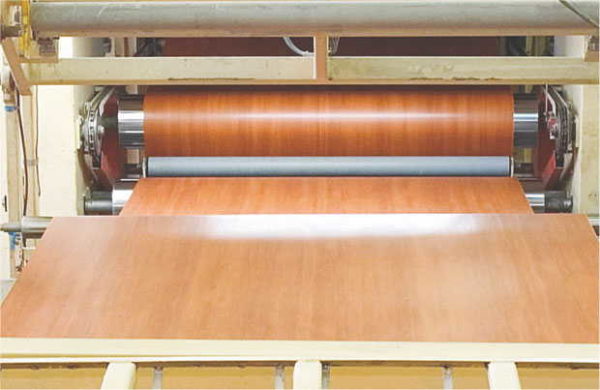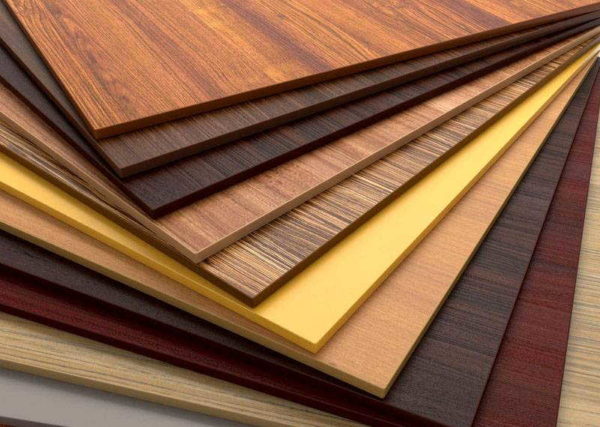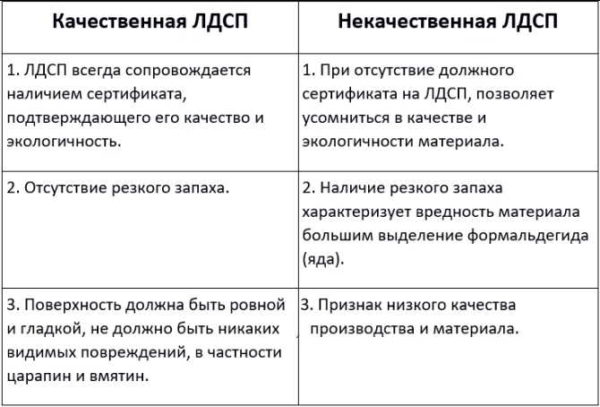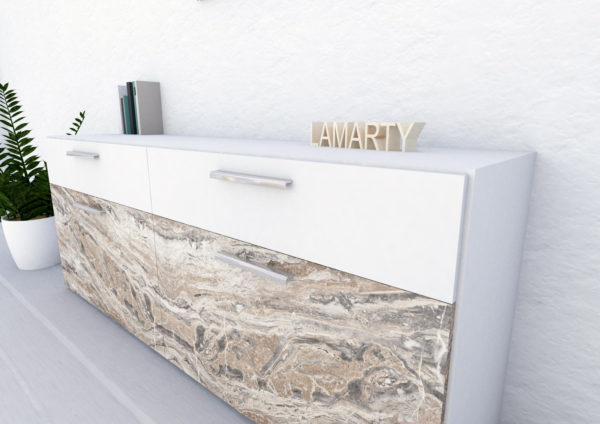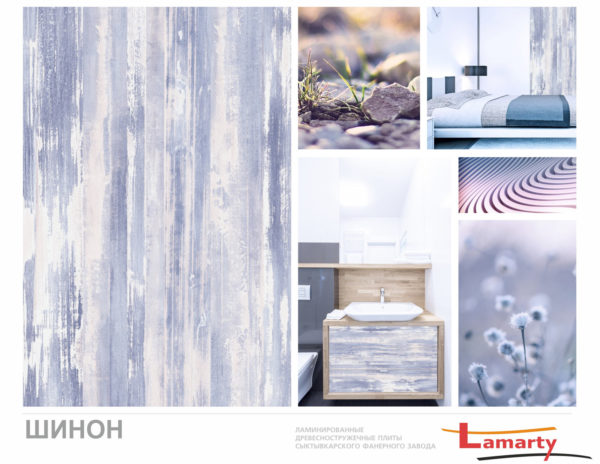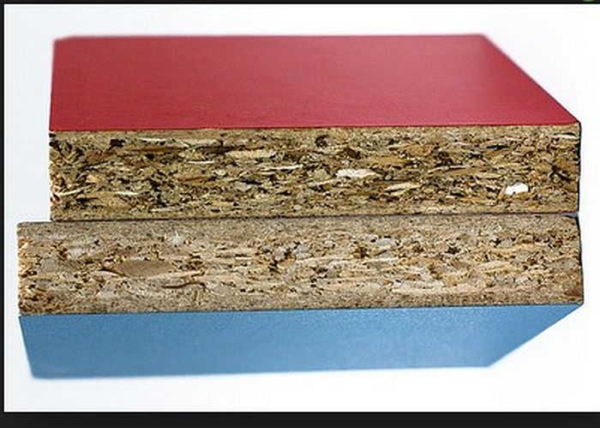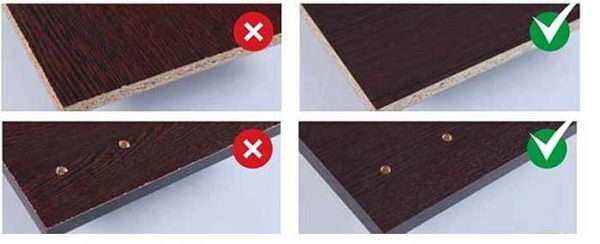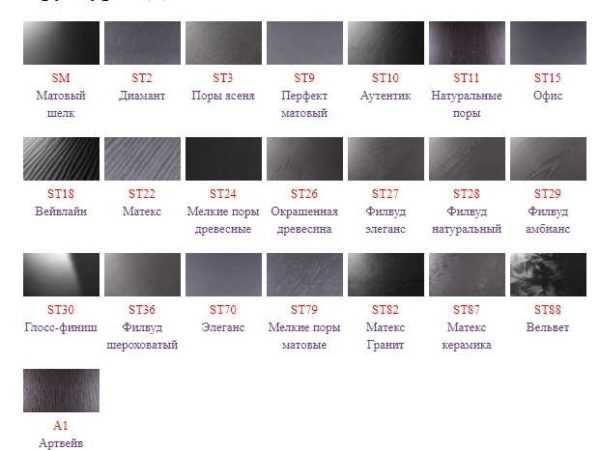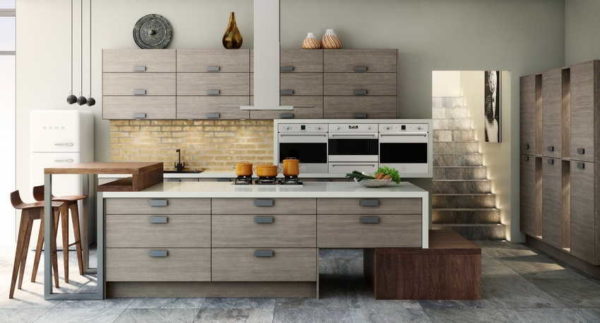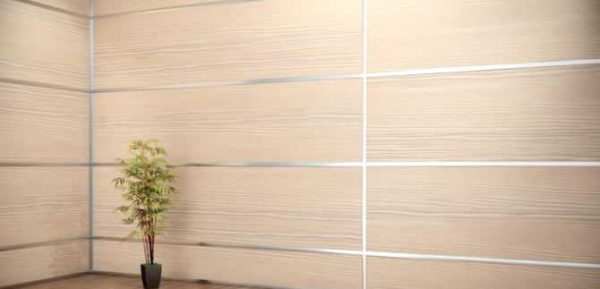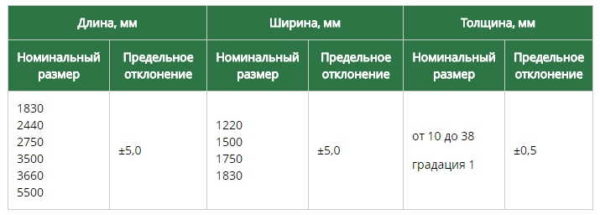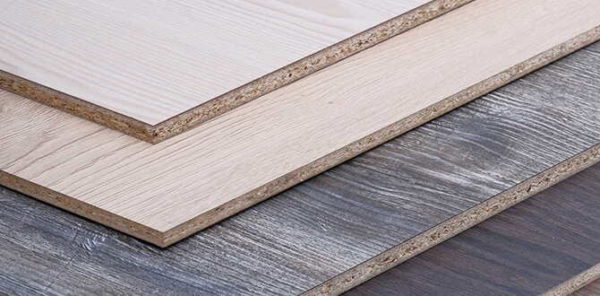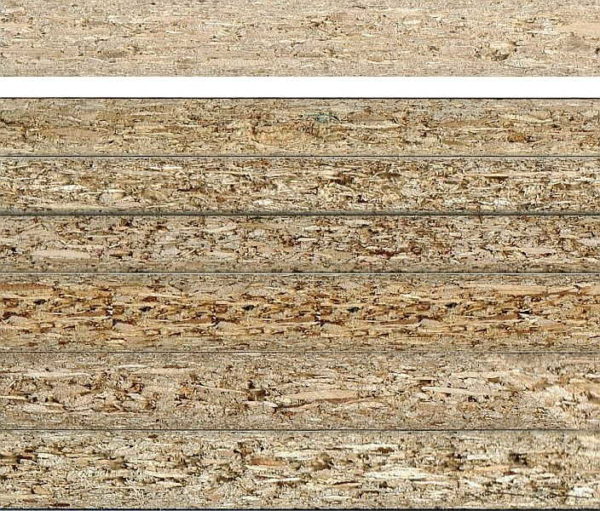Laminated chipboard: production technology, application, choice
Not everyone can independently make wood furniture - certain skills are needed. Even with a joinery board you need to be able to work, and even more so with an array. The situation is much simpler with furniture made of laminated particle boards (Laminated chipboard). It is a sheet material with an already finished face. All that is needed is to assemble the cut-to-size parts. The situation is even simpler with the decoration of the premises: the finished chipboard boards are mounted on the crate, the seams are made out with decorative strips. Let's talk about this material - laminated chipboard.
The content of the article
Production technology
For the production of laminated chipboard (chipboard), a first-class raw material is used - chipboard. It should be without signs of marriage, delamination, extraneous inclusions, etc. Plates are ground, then fed to the press, where the lamination process takes place.
The chipboard sheet is covered with specially treated paper. The color can be different - from monochromatic, to recreate natural materials: wood of different species, stone, cork, etc. Maybe with some kind of pattern. The paper is impregnated with melamine, a substance that does not dissolve in water and most solvents. This impregnation makes the laminating paper strong and moisture resistant.
The prepared chipboard sheet is placed in a special press, a sheet of melamine paper is placed on top. Next, the press comes into play. These are two horizontally located slabs. If necessary, a textured pattern is applied to the lower surface of the upper slab, imitating the structure of wood, stone, etc. Oil heated to high temperatures (140-230 ° С) circulates inside the press plates.
The lower, movable part of the press raises the material laid on it and, for a few seconds, presses it against the upper part of the press. The pressure is high - more than 20 atm, so that the applied textured pattern is pressed into the slab. At the same time, the heating melts the melamine and the surface layer of the "base" chipboard. Melamine penetrates the surface, firmly and rigidly anchoring the paper to the material. After melamine hardens, a strong, rigid film forms on the surface, which is difficult to damage even with sharp and hard objects. The process is repeated on the other side, then the edges are processed.
Properties
Since chipboard is produced on the basis of chipboard, some properties and characteristics are "inherited" from the base material. The binder remains the same - it may contain phenolic resins. Therefore, formaldehyde emissions must be controlled without fail. If this indicator is not indicated on the information sheet, you need to go close to the stack of material and assess the smell. If the chipboard is made on the basis of boards with an emission class not higher than E1, you will not feel a special smell. If there is a smell, we advise you not to react to assurances that the material has just been received from production and after a couple of days / week / month there will be nothing left of the smell. Normal material does not smell - this is an axiom that does not require proof.
The film deposited on the surface still makes adjustments to many indicators:
- Laminated particle boards can withstand regular wet cleaning.If a waterproof material has been laminated, with high-quality glued edges, it can be in high humidity conditions for a long time without any significant changes in geometry.
- Laminated chipboard is more resistant to ultraviolet light, high temperatures, and mechanical stress. You should not, of course, knock on the surface with a hammer, but such a surface can easily withstand the repeated movement of ordinary objects.
- Ease of maintenance. A tough and dense film allows you to easily remove any dirt, since they are not absorbed, but remain on the surface.
- Various design. Films can be monochromatic, of any color from the palette, plus with various effects - metallic, etc. There is a lot of imitation of wood, a little less - stone, ceramic tiles. You can also find various geometric or floral patterns, but there are few of them, such plates are made or brought to order, so they cannot cost little.
At the same time, the flexural strength remains the same as that of conventional Chipboard and depends on the qualities of the source material.
Russian consumers are familiar with Lamarty products manufactured at the Syktyvkar plywood mill. Chipboard Lamarty (Lamarti) allows you to create original decors and furniture.
How to choose high-quality chipboard boards
When choosing chipboard, apart from "smelling" the material, determining the conformity of formaldehyde emission, one should pay attention to the end of the board. The material should be dense, without any large voids. The chips should be compressed, the gaps filled with binder. The presence of cavities of any size is a sign of poor quality.
When trying to stick a solid object into the end (a key to the door, for example), the end must remain intact. If chips fall off during this test, the raw material is of poor quality. It will be difficult to tighten the screws / screws into such a plate even once - they can stagger and fly out. We are not talking about reassembly at all.
If you are buying chipboard for making your own furniture, try to find material with a high birch content. It differs in density, and therefore in weight - a plate of the same size and thickness weighs 30-40% more. It is problematic to drive even an awl into the butt end, let alone keys. Why is this type of chipboard good for furniture? The fact that holes are well milled in it, the screws do not stagger even after re-screwing.
Surface types
In addition to different colors, the front surface of chipboard can be different - smooth, repeating the texture of wood or stone, any other. To make it immediately clear what a laminated surface looks like, letter designations have been developed for the most common samples. Often found:
- SM - smooth, glossy, color can be any, including wood-like, but there are no characteristic irregularities and protrusions;
- SE - a board with a color and surface imitating the structure of wood;
- PE - slightly pimply, like an orange peel;
- PR - porous, resembling the structure of a stone.
There are many more. Large enterprises specializing in the production of chipboard have several dozen types of surfaces. For example, in the photo above, the range of laminated panel surfaces offered by the renowned Austrian manufacturer EGGER.
Application
The main area of application of laminated chipboard is furniture manufacturing. A couple of decades ago, this material did not have any special competitors: almost all cabinet furniture was made precisely from laminated particle boards. Today more and more furniture is made of MDF... This material is much more expensive, but it allows you to create nonlinear surfaces and form patterns of high complexity. All this cannot be done from chipboard.In addition, MDF tolerates high humidity even better.
But the high cost severely limits the distribution of MDF furniture. Therefore, in general, they make combined cabinet furniture: frame, shelves, partitions - from laminated chipboard, facades, countertops - from MDF. A reasonable compromise and no need to decide which is better - MDF or chipboard.
The second area of application of chipboard is finishing work. Chipboard panels can be used to sheathe the walls, avoiding the leveling of the walls with plaster. Although this finish is not at the peak of popularity now, it can be used in interiors of any style. Best of all, wood-grain laminated chipboard panels fit into the classic interior. Plain-colored options can be used in modern style, modern, art deco and even high-tech.
Chipboard: sheet dimensions, shelf thickness
Standard sheets of conventional first grade particle boards are laminated. In size, they can be exactly the same as the base material, and its dimensions are standardized by GOST. Dimensions according to GOST are shown in the table.
If you are going to make furniture, it is advisable to select the size of the sheet in such a way that the remainder is either very small or solid - it can be used for the following products. The companies that deal with the layout have programs that immediately figure out the layout. With their help, you can choose the optimal parameters of the chipboard slab.
A few words about the thickness of chipboard for shelves. If you use a sheet that is too thin or make the shelf too long, under load (and sometimes even without it), the material can bend. Nevertheless, you will not find exact recommendations, since even GOST defines wide tolerances for the density and stiffness of chipboards. But furniture from laminated chipboard is often made, so based on experience, the following recommendations were made:
- with a thickness of 16 mm, the maximum length is 600 mm;
- for 18 mm - 800 mm;
- for 20 mm - 1000 mm.
This data is for shelves with a depth of 30-40 cm and for loose ends (freely lying on holders). As the depth increases, the rigidity increases, which means that the shelf can be made longer. Also, the length can increase if you add a stiffener along the edge - nail / screw on a decorative strip. Well, one more thing: the recommended lengths are given for an average load. If you do bookshelf or you are planning to put stones on the shelf, it is better to take the thickness one step (1-2 mm) more.
Advantages and disadvantages
The advantages of laminated chipboard include a low price, a variety of colors and textures, water resistance, resistance to mechanical damage. All in all, this is a good choice for both finishing work and furniture.
There are also disadvantages:
- Sheet material. To make panels or furniture, you have to cut it out. You can do it yourself even with the help of an ordinary hand saw, but at the same time, laminate chips form along the edge, which does not improve the appearance of the product in any way. Therefore, you have to order the cutting of laminated chipboard in furniture shops. The service is not too expensive, but it is an additional cost.
- The laminated surface is highly resistant to water and water vapor. But the unprotected end absorbs moisture very well, as a result, the edges swell. Therefore, when cutting, it is also necessary to order edging of all ends. Let it be melamine end edge, but the slice must be protected.
- No matter how well the butt is glued, water vapor still penetrates through it. If the furniture is placed in a damp room, the edges will swell over time and the appearance of the furniture or decoration will deteriorate.
- Furniture made of chipboard does not tolerate re-assembly very well.Once you unscrew the screw, you will not tighten it the second time: it will wobble. Larger fasteners can be used. This will help to some extent. You can drill other holes - one centimeter next to it. But, as you know, this does not guarantee one hundred percent result.
- You won't be able to make curly furniture or smooth, rounded lines from laminated boards - this is not the right material. You can decorate with overlays, fittings. No other way.
Generally speaking, laminated chipboard is a good budget option for interior decoration or for creating furniture.

